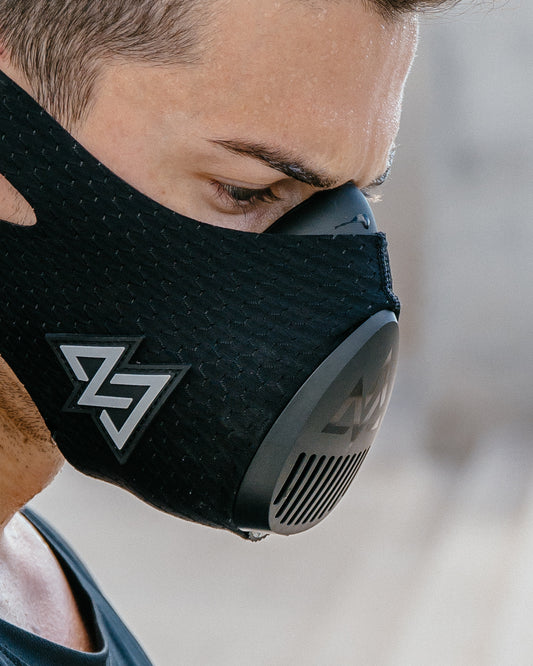#1: Improved Respiratory Stamina When It Counts Most
There are a number of critics out there that question whether or not improved respiratory muscle output will result in increased performance. First let us exercise our common sense for a moment and ask a few simple questions…
- Does exercising at high intensity cause you to breath hard?
- What is the one thing we all do during a brief rest after a hard sprint?
- If we could keep our breathing less labored, even at high intensities, would that improve our stamina and performance?
This list could go on and on but the one thing that everyone can agree on is that breathing hard and exercise intensity go hand in hand. If a reasonably good runner and a deconditioned runner race for time in a mile, it is pretty much a guarantee that the well-conditioned runner will be breathing much easier than the under conditioned runner will be. Now there might be some other mitigating factors such as improved lower extremity type I muscle power output in the better conditioned runner, but more likely than not, the better runner’s pulmonary system is much better equipped to meet high oxygen demands. Thus they are able to run harder for longer. Make sense?
So how then can one say that improved respiratory muscle conditioning won’t improve performance. You could, but making such a statement is extremely inaccurate. Lactic acid is one of the nasty byproducts of exercising. It is used in energy production but once it accumulates it makes it impossible for muscles to continue to work at high power outputs. It also increases the bodies acid balance which cause a global reduction in muscle output over time if intensity levels do not wane. Oxygen is the chief buffering mechanism the body has to counter the effects of lactic acid so that power output can stay higher for longer. The more oxygen you can make available to the body during aerobic and anaerobic work, the harder you can work for longer. Stronger breathing muscles will do just that. Allow you to get more precious air into your lungs to keep you going at peak levels. In other words, when the other guys are gasping for air during your pick-up basketball game…you won’t be.
#2: Improved Core Utilization During Functional Tasks
One of the most poorly understood aspects of core strength is the role the diaphragm plays. The core muscles and the respiratory muscles are one in the same. As a matter of fact, they regularly have overlapping functions depending on the nature of the activity. During a strength training application, the diaphragm and respiratory muscles aide trunk stability via the Valsalva maneuver (increasing intra-thoracic pressure by holding the air in the lungs at the glottis). This extra stability takes the load of the other core muscles and allows them to be more flexible to aide in dynamic movement tasks. The inverse is true during an aerobic activity. If the diaphragm and intercostals are unable to meet the lung inflation demands required for the activity, a whole host of other core muscles will activate to meet escalating oxygen demands. A problem arises during high output activities that needs mentioning however. The non-respiratory core muscles are ill suited for breathing. In addition to that they also have other stabilization responsibilities as well. When these muscles become overactive during breathing they can cramp up. This is yet another reason why a strong diaphragm is so important. Core stabilization is ‘inside out’ originating from the diaphragm and transverse abdominus. If these muscles are strong, the rest of the core musculature will have a strong foundation off which to work.
#3: Increased Post Workout Calorie Expenditure
The body goes into a state called EPOC post workout depending on the intensity of the activity. Even with moderate exercise, EPOC is present to get the body back to a normalized oxidative state to recover from heavy workloads. EPOC is exercise post oxygen consumption and it is a term that explains what the body must undergo to overcome the oxygen debt accumulated during exercise. Higher EPOCs are related to higher post workout calorie consumption. In some instances, this elevated calorie burn can last up to 48 hours. EPOC occurs because the pulmonary system is unable to meet the oxygen demands of the body during the activity. Remember that oxygen plays a vital role in energy production, and maintaining the bodies ph. levels. In the event the lungs cannot adequately meet the oxygen demands of the body due to acidic ph. levels (from lactic acid and other metabolic wastes), the body slows in activity output until oxygen levels can alleviate the burden. Depending on the intensity of the activity, this can take some hours. The good news is that this process also costs the body a substantial number of calories as well. You can turbo charge this process by using the Training Mask during your workouts. This reduces the availability of oxygen during your workout so you can have higher EPOC levels post workout to overcharge your calorie burn for multiple hours.
All Copyrights belong to TRAININGMASK.LLC (R) - Do not copy or duplicate








